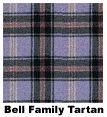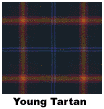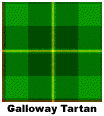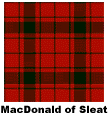
Much has been said about the Kilt and its significance to Scottish history. It is generally accepted that as an item of clothing,  the kilt is a modern development which refers only to the style or cut of the cloth and how it is worn. In contrast, the Plaid or tartan style of cloth that is now used to identify individual Clans has its origins in far greater antiquity. the kilt is a modern development which refers only to the style or cut of the cloth and how it is worn. In contrast, the Plaid or tartan style of cloth that is now used to identify individual Clans has its origins in far greater antiquity.Originally the Scots were Irish invaders of the land from Irish Dalriada and their rule was derived from the Irish High King. The Norse invasions around 800 AD separated these Scots from the Irish and created the new country, Scottish Dalriada. With the conquest of the Picts, Scottish Dalriada became Alba and later still the country we now call Scotland. But the style of dress remained the same in both Ireland and Scotland until the middle of this millenium.
While the meaning of the word plaid is well known in modern English, the meaning in Gaelic is completely different. In Gaelic, Plaide means blanket and the Brat was used for this purpose besides that of the cloak. The word tartan also has a more archaic meaning. In French 'tiretaine' means a type of cloth, particularly light wool. Through these means we have discovered that the plaid was already is use around the 5th century AD.
Their aspect is terrifying...They are very tall in stature, with rippling muscles under clear white skin. Their hair is blond, but not naturally so: they bleach it, to this day, artificially, washing it in lime and combing it back from their foreheads. They look like wood-demons, their hair thick and shaggy like a horse's mane. Some of them are clean-shaven, but others - especially those of high rank, shave their cheeks but leave a moustache that covers the whole mouth and, when they eat and drink, acts like a sieve, trapping particles of food...The way they dress is astonishing: they wear brightly coloured and embroidered shirts, with trousers called bracae and cloaks fastened at the shoulder with a brooch, heavy in winter, light in summer. These cloaks are striped or checkered in design, with the separate checks close together and in various colours.
With further research one finds the color system of rank put in place by either Tighernmas or Eochaid, the seventh and eighth of the Milesian line of Kings in Ireland. They lived about 800 BC and incorporated the system of distinguishing the various classes and professions by the colors in their dress. A King or Queen could wear seven colors; a poet or Ollam six; a chieftain five; an army leader four; a landowner three; a rent payer two; and a serf one color only.
Thus it seems that the modern plaid has it's roots from a time almost three millennia ago. An apparent later development of the color system was the Brat. The Brat whether in use as a cloak or as a Plaide allowed the identification of an individual day or night. While the original color system of distinguishing classes is no longer in use, the plaid has evolved from an individual identifier to one of an entire Clan. The Tartan and its particular pattern of weaves and color now identify the family. By passing the right of wear of the five-color plaid from the chieftain to all relations we now have the modern tartan which is in use today. by BW, December, 1999 Suggested Reading: The Story of the Irish Race by Seumas MacManus, The Devin-Adair Company, 1974 Old Irish and Highland Dress by H.F. McClintock Links: The Origins of the Kilt on Gathering of the Clans The Origins of the Tartan on Gathering of the Clans The Tartan on Gathering of the Clans The Landings of Caesar in Britain, 55 and 54 BC: Athena Review Celtic Dress in the 16th Century
|
Thursday, December 26th, 2019
Attention visitors: Tartans.com is back. Please note that this is a snapshot of the site as it existed nearly 20 years ago and you may encounter broken links; we are still combing through the site and correcting those as we find them. Please also note that some sections are currently not functional, primarily the discussion forums/clan chat boards.
|
** HOME - First Time Visitors - Glossary - - Contact Us ** Awards | Bibliography | Clan Calendar | Clan Chat | Clan Finder | History | Famous Scots | Genealogy | Great Hall of the Clans | Links | News and Features | Scots on the Net | Search | Site Map The Gathering of the Clans
Copyright 1995- Tartans.com - All Rights Reserved. |

 After even further investigation we discover the account of Diodorus Siculus (c. 90-21 BC), Greek historian, born in Agyrium, Sicily in describing the Celts:
After even further investigation we discover the account of Diodorus Siculus (c. 90-21 BC), Greek historian, born in Agyrium, Sicily in describing the Celts: Siculus' observations were written about 50 BC and were based on descriptions of the Roman invasion of Gaul. Clearly in the story one can pick out a description of the plaid cloaks worn by the Celts.
Siculus' observations were written about 50 BC and were based on descriptions of the Roman invasion of Gaul. Clearly in the story one can pick out a description of the plaid cloaks worn by the Celts. While its Tartan material was extremely versatile considering the changing weather conditions of the climate.
While its Tartan material was extremely versatile considering the changing weather conditions of the climate.